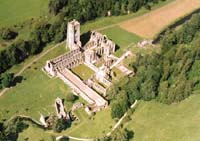| |
 |
North Yorkshire Fountains Abbey |
In 1132 Archbishop Thurstan of York brought a small group of Benedictine monks from St Mary's Abbey in York to a site on the River Skell, near Ripon, where they sought a return to the purest form of monastic life.
Archaeology has revealed that the first buildings were of timber, but construction of a stone church began in 1136 shortly after Fountains became a daughter house of the Cistercian headquarters at Clairvaux. In 1144 Henry Murdac became Abbot and set about rebuilding on the traditional Cistercian plan. The church was extended and a vast cloister laid out on its south side.
In 1146 a fire destroyed part of the abbey, but major rebuilding did not begin until c. 1160. A monumental new church took about 20 years to complete. The style is austere, as Cistercian practice demanded, but some concession to decoration was made in moulded column bases and scalloped capitals. The 1160s also saw the enlargement of the cloister ranges, including that on the west which formed the lay brothers' refectory and dormitory. On the east a new, enlarged chapter house was completed by 1170. Some ornamentation was allowed here, for example on the corbels below the arches supporting the roof. In the southern half of the east range was the monks' dormitory and the fine staircase still survives. Other buildings of the 1160s include two guest houses, amongst the best preserved halls of their type in England.
The principal contribution of Richard Pipewell, who became Abbot in 1170, was the refectory in the south cloister range, built in an early Gothic style. A remarkable feature is the row of wash basins by the main door which were fed by a piped water supply.
Bibliography
Coppack, G., 1993. Fountains Abbey (London)
Mauchline, M. and Grieves, L., 1988. Fountains Abbey and Studley Royal (London, National Trust)
Pevsner, N., 1966. The Buildings of England, Yorkshire: the West Riding (London, Penguin), 203-13